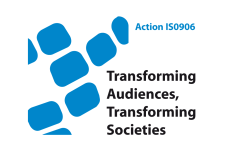- About the Action
- Events
- PhD workshop - Ljubljana 2014
- Action Open Conference - Ljubljana 2014
- New Media and Participation conference - Istanbul 2013
- Belgrade meeting 2013
- Media literacy research and policy - Brussels 2013
- ICA Pre-Conference 2013
- Tampere meeting 2013
- Budapest workshop 2012
- Milan meeting 2012
- Brussels PhD workshop 2012
- Brussels Action workshop 2012
- London meeting 2011
- Zagreb Conference 2011
- Lisbon meeting 2010
- Affiliated events
- WG 1
- WG 2
- WG 3
- WG 4
- Cross-WG
- Output
Researching LGB media use: Reflections on inclusivity and diversity.
Dhoest, A. (2011). Researching LGB media use: Reflections on inclusivity and diversity. . Transforming Audiences 3 2011: "Online & Mobile Media, Everyday Creativity and DIY Culture". 1-2 September.
Abstract: This paper reflects on a combined quantitative (online survey, N= 761) and qualitative (in-depth interviews, N = 60) research project on LGB media uses. This project aimed to map the field of LGB media uses, as studies so far have mostly focused on particular sub-groups, issues, media etc. While studying this minority group, the aim was to be as inclusive as possible. However, such research is riddled with problems. To start, the very terminology used is problematic: while LGBT would be the evident term (at least in English), in Flemish Dutch the term most used is 'holebi' (an equivalent of LGB), a word we will here use as it was preferred by respondents and because there were no transgendered people in the sample. This leads to a second point on sampling: it is extremely difficult to reach a large and diverse sample, particularly for quantitative research where random sampling is key. A wide call in different media led to quite a large sample, but it was biased to higher educated 'out' LGBs who, when offered a seven point scale of sexual identity, mostly identified as exclusively or primarily lesbian or gay. This has consequences for the analysis: given the small group of bisexuals (which complicated separate analysis), the respondents were considered as one community, thus (partly) imposing a straight-gay binary although in reality more fluidity is present. Overall, the respondents were quite happy to identify with the term 'holebi', and their sexuality was indeed a relevant dimension in media use (particularly before and at the time of coming out), but there were also important differences in media use related to gender, age and level of education. Particularly in the interviews, it became clear how sexual identity is part of a broader set of identifications, none of which individually 'determines' media use but which become salient and relevant in particular contexts.

